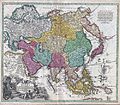ගොනුව:1730 C. Homann Map of Asia - Geographicus - Asiae-homann-1730.jpg

මෙම පෙරදසුනෙහි විශාලත්වය: 687 × 600 පික්සල. අනෙකුත් විභේදනයන්: 275 × 240 පික්සල | 550 × 480 පික්සල | 880 × 768 පික්සල | 1,173 × 1,024 පික්සල | 2,346 × 2,048 පික්සල | 4,000 × 3,492 පික්සල.
මුල් ගොනුව (4,000 × 3,492 පික්සල, ගොනු විශාලත්වය: 5.26 මෙ.බ., MIME ශෛලිය: image/jpeg)
ගොනු ඉතිහාසය
එම අවස්ථාවෙහිදී ගොනුව පැවැති ආකාරය නැරඹීමට දිනය/වේලාව මත ක්ලික් කරන්න.
| දිනය/වේලාව | කුඩා-රූපය | මාන | පරිශීලක | පරිකථනය | |
|---|---|---|---|---|---|
| වත්මන් | 16:35, 16 මාර්තු 2011 |  | 4,000 × 3,492 (5.26 මෙ.බ.) | BotMultichill | {{subst:User:Multichill/Geographicus |link=http://www.geographicus.com/P/AntiqueMap/Asiae-homann-1730 |product_name=1730 C. Homann Map of Asia |map_title=Recentissima Asiae Delineatio : Qua Imperia, eius Regna, et Status, Unacum novissimis Russorum detect |
ගොනු භාවිතය
පහත දැක්වෙන පිටුව විසින් මෙම ගොනුව භාවිතා කෙරෙයි:
ගෝලීය ගොනු භාවිතය
පහත දැක්වෙන අනෙකුත් විකියන් මගින් මෙම ගොනුව භාවිතා කරයි:
- ca.wikipedia.org හි භාවිතය
- de.wikipedia.org හි භාවිතය
- el.wikipedia.org හි භාවිතය
- en.wikipedia.org හි භාවිතය
- es.wikipedia.org හි භාවිතය
- fa.wikipedia.org හි භාවිතය
- hu.wikipedia.org හි භාවිතය
- hy.wikipedia.org හි භාවිතය
- mk.wikipedia.org හි භාවිතය
- mr.wikipedia.org හි භාවිතය
- ms.wikipedia.org හි භාවිතය
- pnb.wikipedia.org හි භාවිතය
- pt.wikipedia.org හි භාවිතය
- ru.wikipedia.org හි භාවිතය
- sq.wikipedia.org හි භාවිතය
- ta.wikipedia.org හි භාවිතය
- th.wikipedia.org හි භාවිතය
- ur.wikipedia.org හි භාවිතය
- uz.wikipedia.org හි භාවිතය
